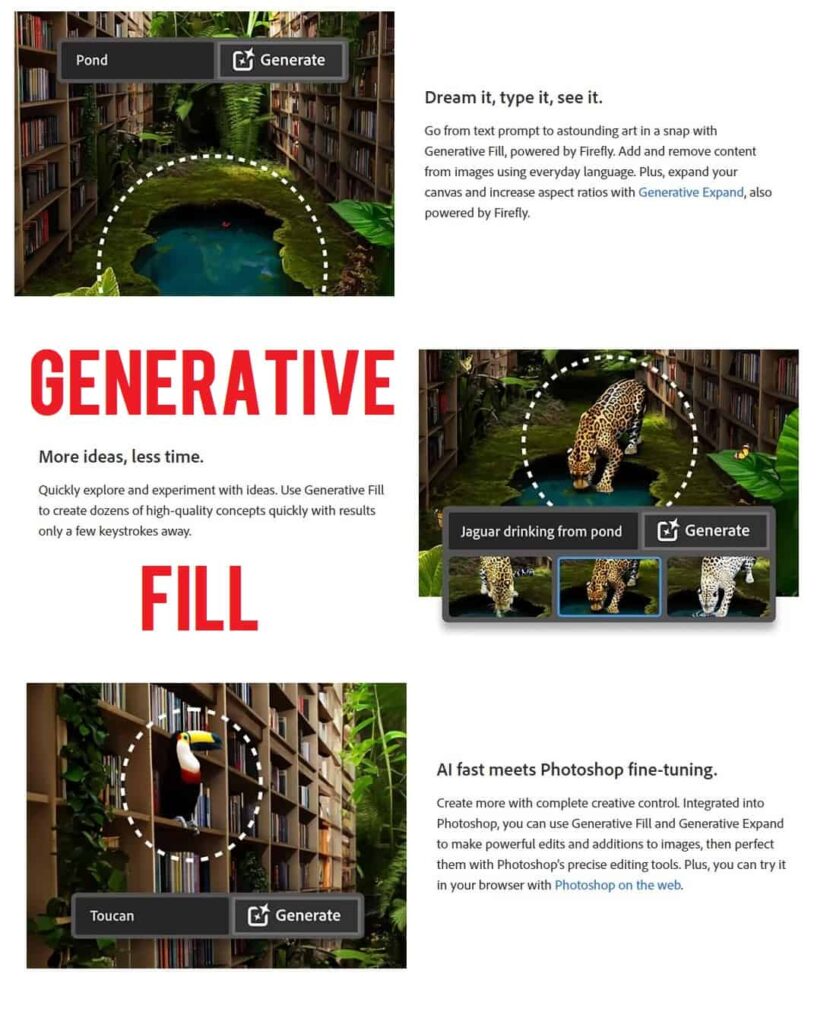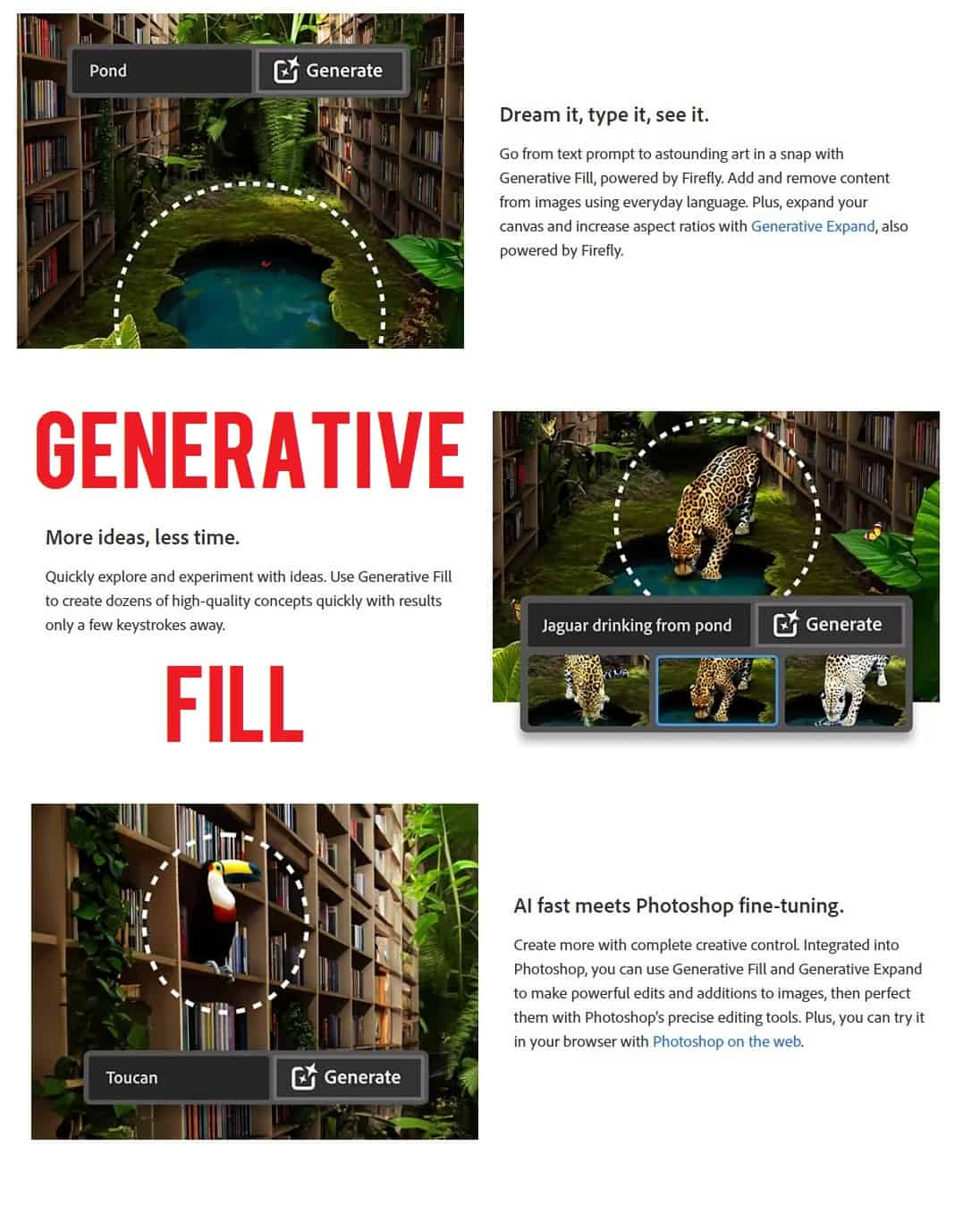Adobe’s Generative Fill is taking the design world by storm, offering a powerful set of AI-driven tools that can transform your creative projects. In this comprehensive guide, we’ll delve deep into Generative Fill, exploring its features, benefits, pricing, and much more. Whether you’re a seasoned Adobe user or just getting started, you’ll find valuable insights here to enhance your design workflow.
What is Generative Fill?
Generative Fill is part of Adobe’s Firefly-powered generative AI tools, designed to make your design tasks more efficient and creative. It includes features like Generative Fill, Generative Recolor, Text Effects, and more. These tools are now out of beta and available in the general version of Adobe Photoshop.
How to Access Generative Fill
Using Generative Fill is a breeze. Follow these simple steps:
- Update your Adobe Photoshop to version 25 or above.
- Open your Photoshop software.
- Make a selection around the area you want to edit.
- If you don’t see Generative Fill, go to the “Window” menu and make sure “Textual Taskbar” is selected.
- Click on Generative Fill.
- Agree to the prompts, and click on “Generate.”
- Watch as distracting elements disappear like magic.
The Evolution of Generative Fill
Generative Fill has come a long way. Initially in beta, it’s now available to all subscribers for commercial use. This is fantastic news for designers, but it’s essential to understand why it’s no longer unlimited.
The Limitation: Cloud Computing
Generative AI requires immense computational power, which is not feasible on local machines. Instead, Adobe harnesses the power of cloud computing to perform these complex tasks. However, this cloud-based processing comes at a cost, and this is why Generative Fill is no longer unlimited.
Generative Credits: Your Currency in Adobe’s Creative Universe
To use Generative Fill and other generative AI features, you’ll need Generative Credits. These credits are like points that get consumed every time you use a generative feature. The number of credits you have depends on your Adobe plan.
Here’s a breakdown of the different plans and the corresponding credits:
| Adobe Plan | Monthly Credits |
|---|---|
| Creative Cloud All Apps | 1000 |
| Creative Cloud Single App | 500 |
| Creative Cloud Single App (e.g., Photoshop, Premiere Pro) | 100 |
| Adobe Stock Subscriber | Varies (check your plan) |
| Adobe Free User with an Adobe ID | 25 |
Keep in mind that unused credits do not roll over to the next month; they reset each month.
How Credits are Consumed
The number of credits consumed depends on the specific generative feature you’re using. Currently, Adobe charges one credit for each use of Generative Fill. However, as Adobe introduces new features like higher resolution generations, animations, videos, 3D, and more, some of these may require more credits per generation.
What Happens When You Run Out of Credits?
Running out of credits doesn’t mean you’re locked out of using Generative Fill; it just means the process may be slower. Here’s what to expect:
- Creative Cloud or Adobe Stock Subscribers: You can continue using the features, but it might be slower.
- Adobe Express or Adobe Firefly Paid Users: You can still use Generative Fill, but you’re limited to two generations of standard images or vector generations per day.
Buying Additional Credits
While it may not be available at the moment, Adobe plans to introduce a subscription plan starting at $4.99 per month, which will provide an additional 100 monthly generative credits. This offers flexibility for power users who need more credits for their projects.
Compensation for Adobe Stock Contributors
Adobe’s Generative AI was built using Adobe Stock content. If you’re an Adobe Stock contributor, you might be wondering if you’ll receive compensation. The answer is yes, Adobe plans to provide compensation to Adobe Stock contributors annually.
The exact amount of compensation and the process will be detailed on Adobe’s website. It’s a positive step toward acknowledging the contribution of stock contributors to this AI development.
Content Credentials: Transparency in Design
Transparency in design is crucial, and Adobe is committed to it. Any document or content created using Generative AI will be tagged with “Content Credentials.” This tag informs viewers that AI, specifically Adobe Firefly AI, was used in the creation process.
For instance, when you export an image created with Generative AI, you’ll see this tag in the export settings. This helps maintain transparency and trust in the design community.
How Much Credits Will It Cost?
Now that you understand the credit system, you might be wondering how much it will cost for various design tasks. The number of credits consumed varies based on the complexity of the task. Currently, Adobe charges one credit for each use of Generative Fill, but this could change as new features are introduced.
Here’s a hypothetical breakdown of credit consumption for common design tasks:
| Design Task | Credits Required |
|---|---|
| Removing a distracting object with Generative Fill | 1 credit |
| Recoloring an image with Generative Recolor | Varies |
| Applying text effects with Generative AI | Varies |
Please note that the credit system is subject to change, and it’s essential to check Adobe’s official website for the most up-to-date information.
Creative Possibilities with Generative Fill

Now that you’re familiar with Generative Fill and how credits work, let’s explore some creative possibilities this tool opens up for designers:
1. Object Removal
Generative Fill excels at removing distracting objects from images. Whether it’s an unwanted background element or an imperfection, Generative Fill can make it disappear seamlessly.
2. Background Replacement
Want to change the background of a photo without the hassle of manual selection and masking? Generative Fill can help you achieve stunning background replacements effortlessly.
3. Artistic Recoloring
With Generative Recolor, you can transform the color palette of an image, creating unique and eye-catching variations.
4. Text Effects
Generative AI can generate captivating text effects that can enhance your typography and make your designs stand out.
These are just a few examples of how Generative Fill can elevate your design projects. It’s a powerful tool that combines the precision of AI with the creativity of human design.
The Future of Generative AI
Adobe has ambitious plans for the future of Generative AI. They aim to introduce features like higher resolution generations, animations, videos, 3D modeling, and more. While these advanced features will likely consume more credits, they promise to take your design projects to the next level.
Conclusion
Adobe’s Generative Fill is a game-changer for designers, offering a blend of AI-driven efficiency and creative potential. While the introduction of Generative Credits has limited its unlimited usage, it ensures a sustainable and scalable approach to AI-powered design.
As you embrace Generative Fill and explore its capabilities, remember that creativity knows no bounds. Use this tool to push the boundaries of your design projects and create visual masterpieces that leave a lasting impression.
In the dynamic world of design, staying updated with the latest tools and trends is essential. Adobe’s commitment to innovation ensures that Generative Fill will continue to evolve, offering even more exciting possibilities for designers in the future.
So, whether you’re removing distractions, adding stunning text effects, or embarking on ambitious design ventures, Generative Fill is your trusted companion on the creative journey. Embrace the power of AI and watch your design visions come to life.
For the latest information on Generative Fill, credits, and Adobe’s AI-powered tools, visit Adobe’s official website.












